Further Mindthots - Spring bars, Straps, Noisy Rotor Bearings and Regulating.
Spring bars
The spring bars that come with the Parnis are rather slimline, and easily removed. As a consequence of their slenderness, the original strap has a fair amount of loose play about them. Wary of the flawed lug hole mentioned earlier, I wanted to fit stronger spring bars to keep the leather strap more securely in place.
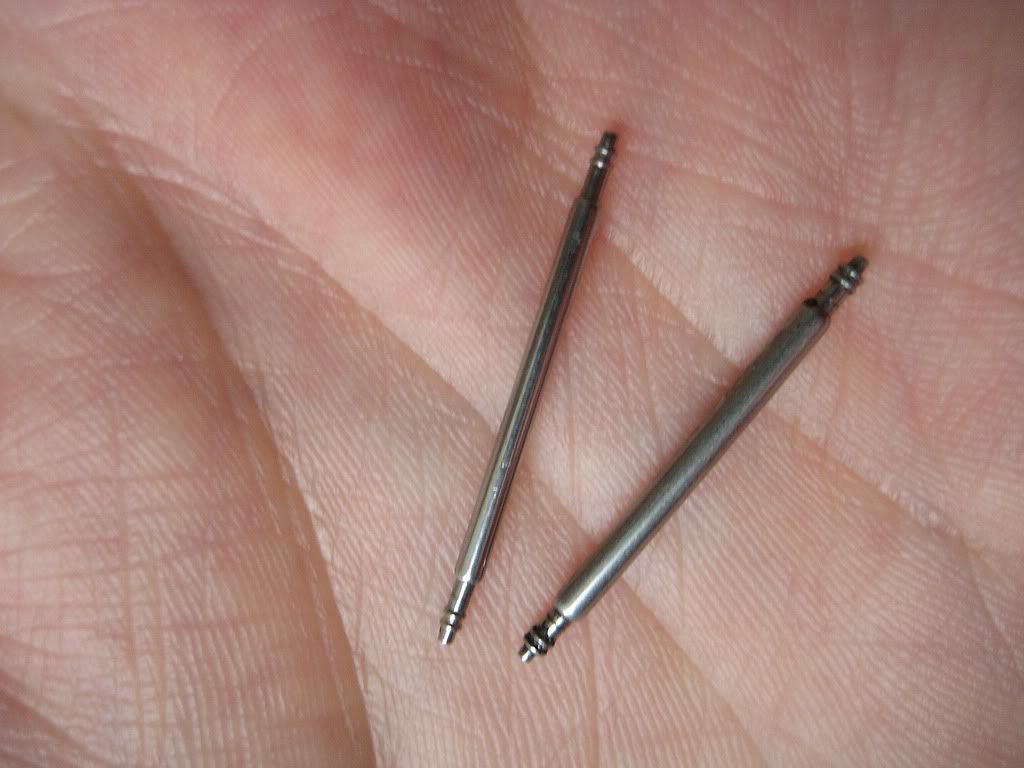 | ||||
| Original spring bar on the left, aftermarket spring bar on the right. The Parnis takes a 22 m.m. strap. |
With the uprated spring bars in place, the original strap has less play - it just feels more secure. The Parnis Power Reserve is not the lightest of watches, so I'm particularly keen on decent spring bars.
~
Straps
Depending on the seller, I've seen the Parnis Power Reserve offered with either black or honey brown leather straps, fitted with conventional or deployment buckles, or a Nato style synthetic strap. My personal preference was to go with a honey brown leather strap, reasoning that this Parnis looks too dressy to suit a Nato strap, and that if I wanted a black strap, I already had a decent one of the correct (22mm) size.
As it turns out, the honey brown strap supplied is better quality than I'd expected; stitched as well as glued, leather rather than "leather like"; it's quite comfortable, with a robust brushed steel clasp that matches the watch case.
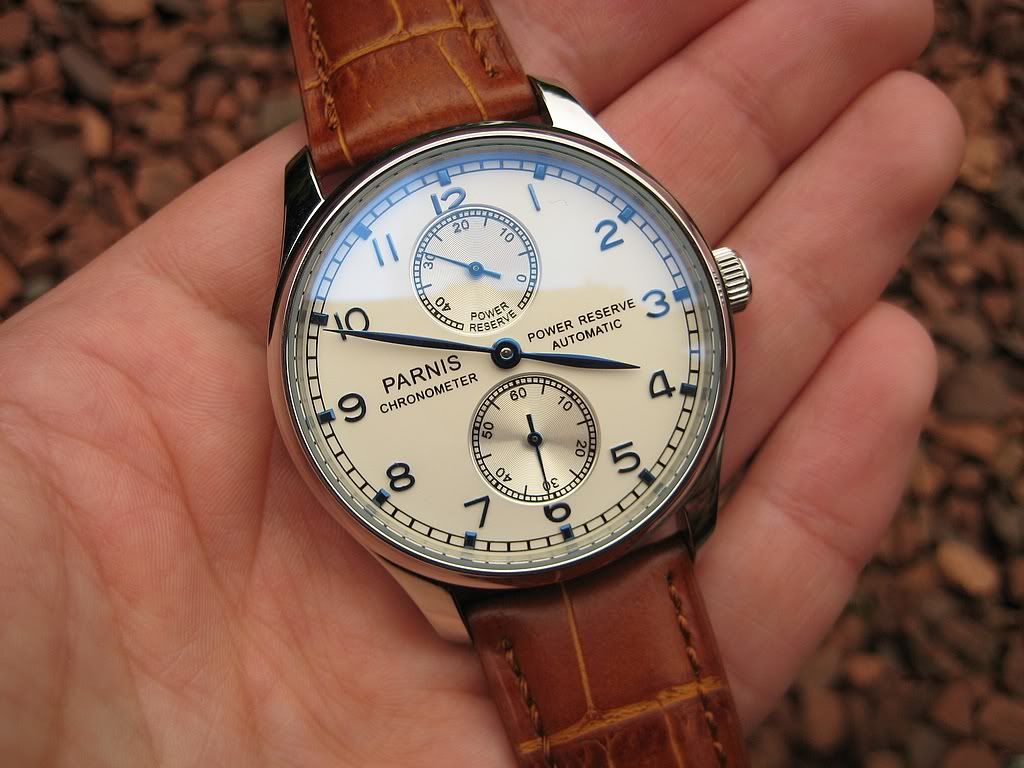 |
| The factory fitted 22 m.m. honey brown stitched leather strap. |
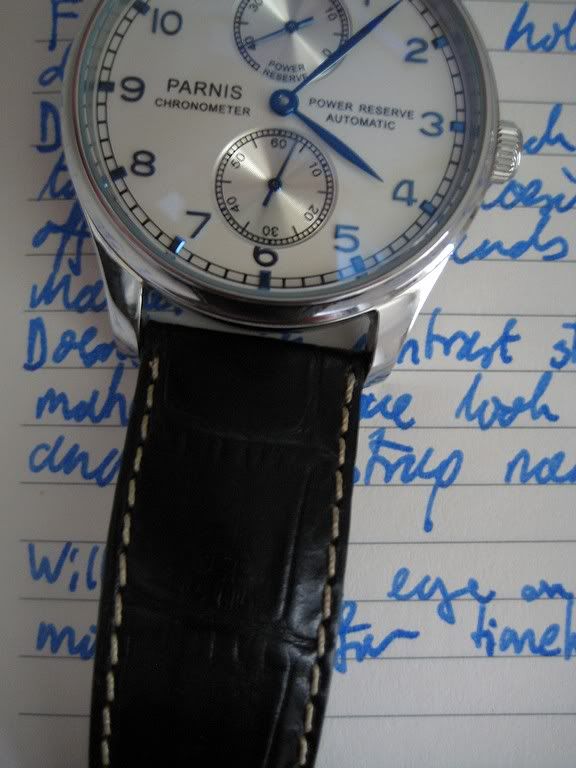 |
| I didn't take to this black ZRC strap when paired with the Parnis. |
 |
| The contrast stitching in particular seemed to lend the case an ungainly appearance. |
~
Rotor Bearings
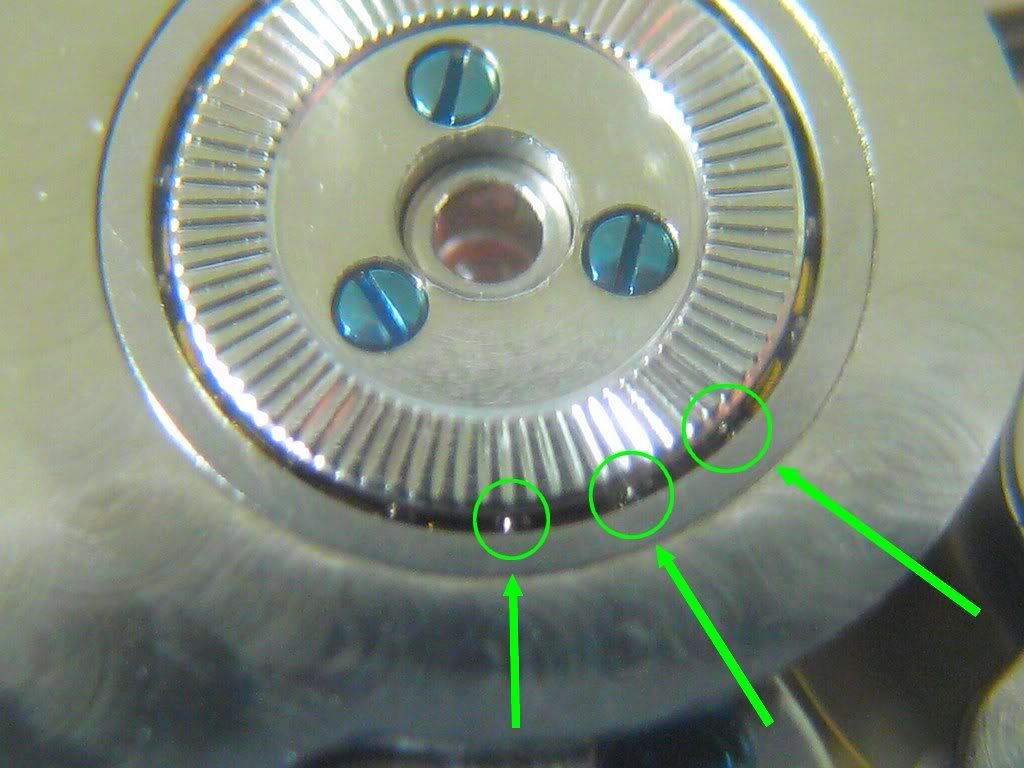 |
| Cacophonous bearings. |
I gave the watch a week of wear in the hope of the factory fresh bearings quieting down. This didn't do much for the noise, so when I read Articman's mention of silicon greasing the rotor bearings on a WatchuSeek thread, I thought I'd have a go too. After greasing, the rotor noise is less rackety and more composed.
Here's a before and after comparison. The difference is not dramatic - I didn't want to pack the bearings with grease. While the rotor is a little less free spinning after greasing the bearings, 2 hours of very light use is still enough for the power reserve hand to move from an indicated 21 to an indicated 40 hours.
I thought some video clips would best serve to illustrate this section of the review, rather than try to describe the noise. As with the earlier hand winding clip, I've included some bubble wrap rustling as an auditory reference, the microphone on this camera tends to emphasise the treble in an artificial way.
Bearing noise out of the box, prior to greasing. The rotor is very free spinning!
After applying silicon grease to the bearings, the rotor still winds the mainspring without difficulty.
Wearing the Parnis backwards to demonstrate wrist winding after noise dampening the bearings with silicon grease.
To grease the bearings, I used blu tack to open the screw back case, some silicon grease I had left over from fountain pen repair, and a plastic CD envelope as a soft, lint free applicator. I didn't want to remove the rotor for this undertaking - my good screwdrivers are magnetised, I'd read that the blued screws are painted rather than heat treated, and I didn't trust myself not to mess something up.
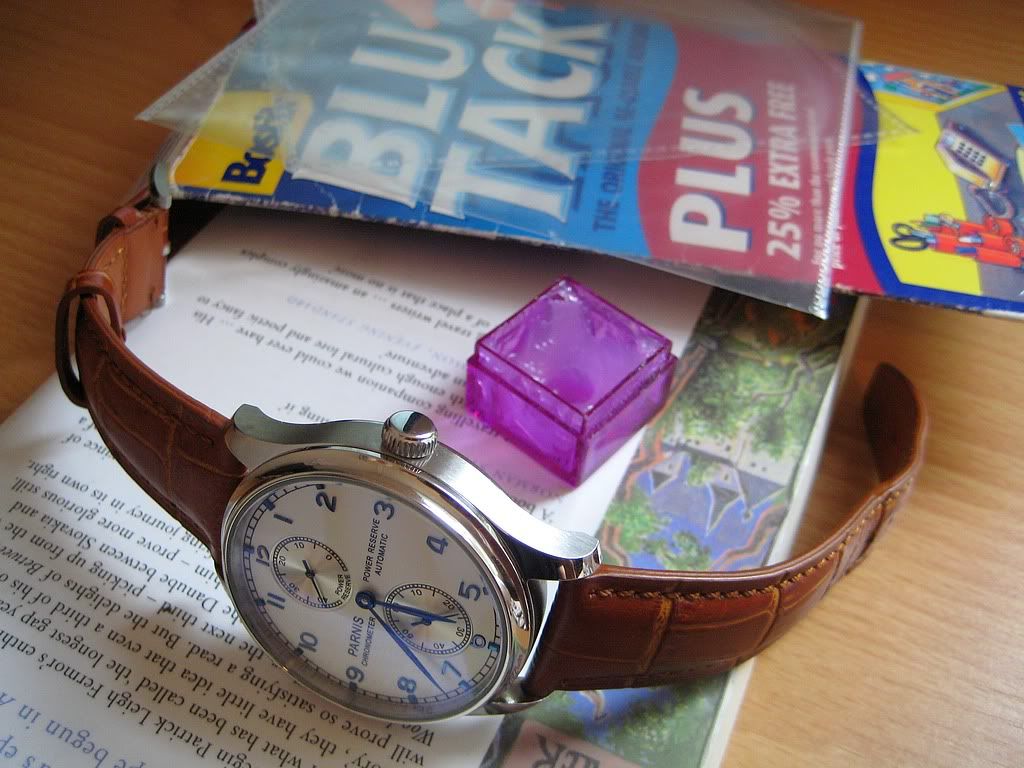 |
| From foreground to background: the Parnis, some silicon grease, a plastic CD envelope, and blu tack. |
First step - screwing off the exhibition case back. I didn't want to stress the glass, so I applied the blu tack to only the metal area, and twisted off the case back.
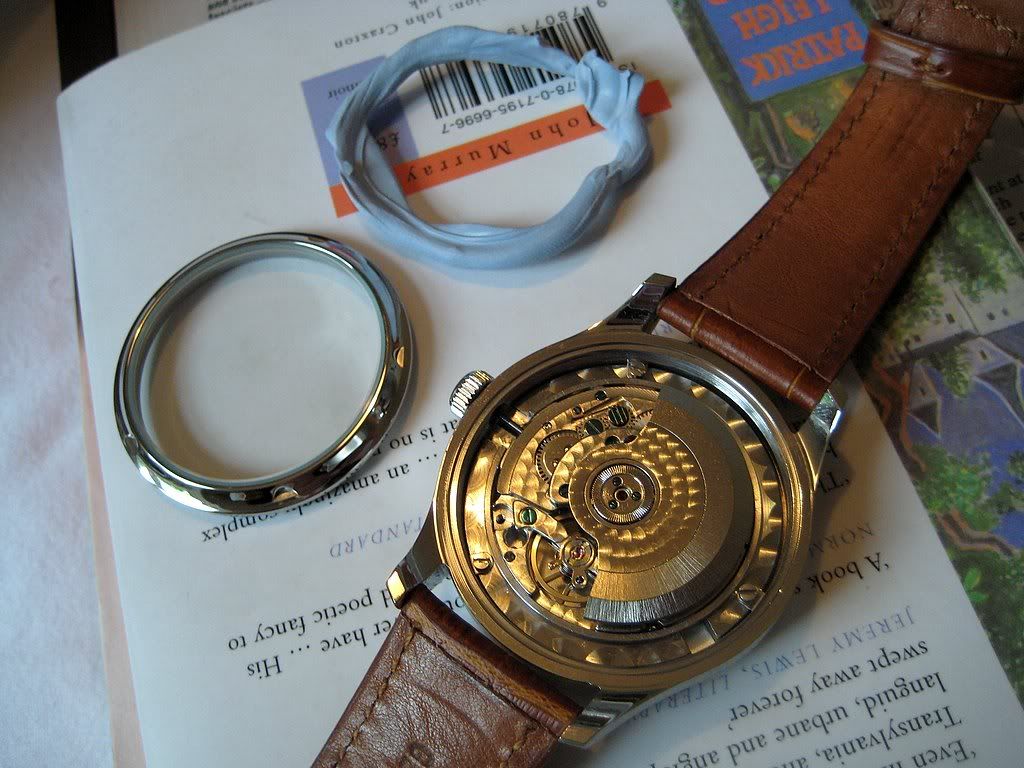 |
| The case back, some Blu Tack, and the exposed movement. |
A closer look at the movement shows the rotor bearings (about 17 of them, arranged in a ring) a little more clearly. In the photos below, some of the bearings are highlighted in green.
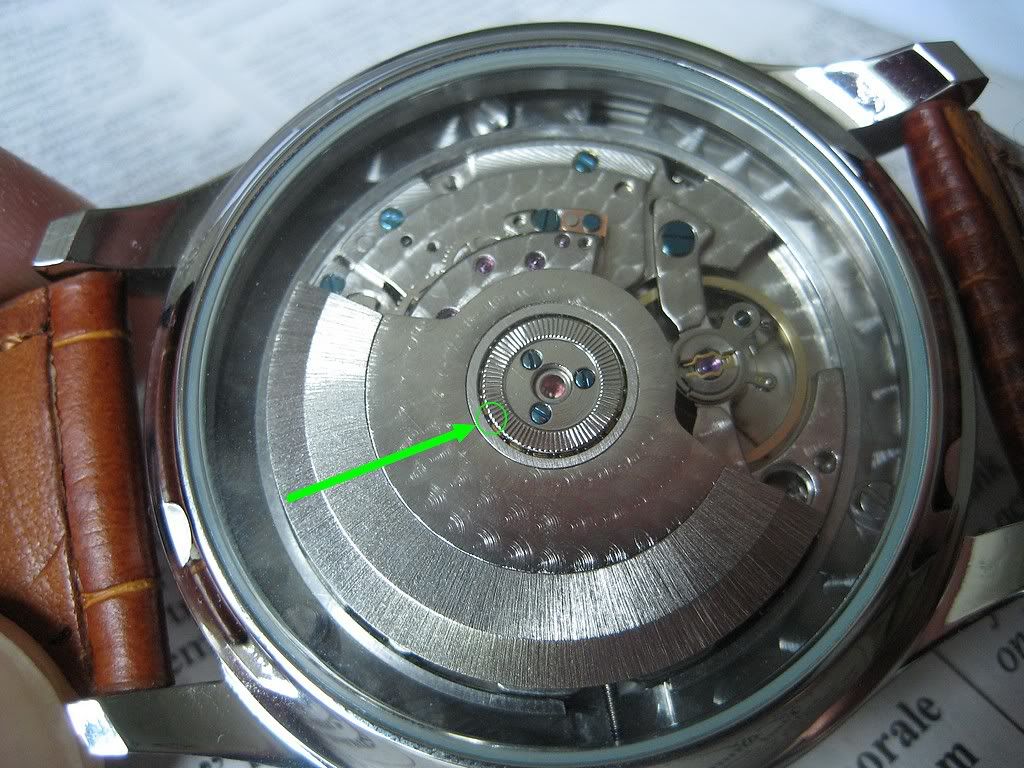 |
| Arrowed & circled - one of the Parnis' winding rotor bearings. |
 |
| Some more of the fellows. |
Greasing the bearings involved dipping a corner of the CD envelope in silicon grease, introducing it perpendicularly to the valley in which the bearings sit, and then giving the watch a shake to revolve the rotor, in the hope of evenly distributing the grease. I gave it three thin applications, at different points in the valley's circumference.
 |
| The greased CD envelope corner, circled in green. |
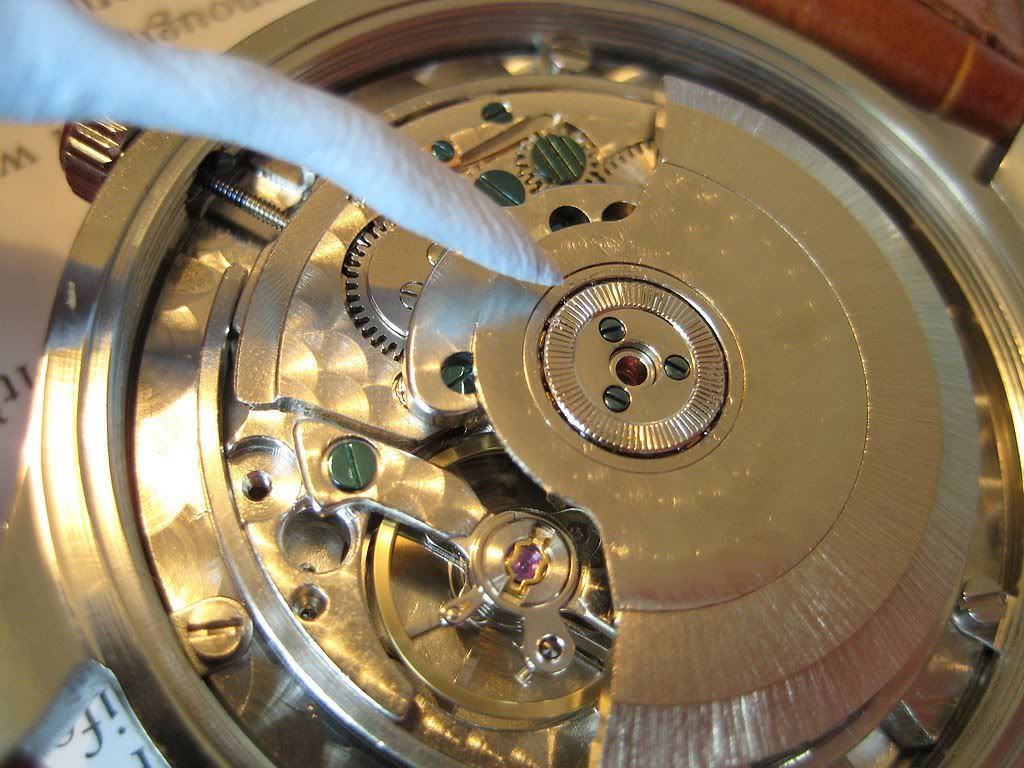 |
| It's about time I got some proper Rodico for this sort of thing! |
After hand tightening the case back into place, I torqued it down with the blu tack (I very much recommend hand tightening first if using blu tack, to minimise the risk of cross threading the case back). Notice the neat scalloping on the double bridge of the balance and winding rotor in the following photo, the exhibition case has a lot to show off!
 |
| Finishing up... |
 |
| ... All done. |
~
Regulating
I've kept the blu tack handy, as I'm still regulating the movement. I'm quite clumsy and out of practise! The watch arrived gaining 8 seconds a day, resting crown up overnight. At the time of writing, I have it losing 5 seconds a day, dial up overnight, going by greenwichmeantime.com.
Fantastic from start to finish!!
ReplyDeleteThe only detailed review of a Paris on the web!
I am going to order one tonight, still can't make my mind up on weather I should get this one or the other with the seconds at 9 o clock?
thanks for posting this review, I'm sure many people like me four it extremely useful.
Cheers
Thanks for reading Anon! I hope the review helps in your choice, I try to be fair. If you have a look on the references post (right after this one) I've linked to a couple more Parnis reviews I found very interesting.
ReplyDeleteThanks Flounder. I placed an order with Jackson for the same watch you have! (the Parnis Portuguese homage)
ReplyDeleteI know I'am going to be bothered by the noise so I'll follow the instructions in your review since the noise reduction seems significant in the YouTube samples you posted (thanks so much for that)
I will keep you posted and hope that I will not have to go through the torture of waiting for 3 weeks and then going through the return process in case the watch shows up with some major defects.
Noisy rotor bearing is a sign of no fine-grinding/polishing of the ball races, definitely a point where economy has been carried too far. But it's not typical for Chinese movements. I had several ETA-Valjoux 7750/51 with the same phenomenon. It manifests itself more when the rotor can freewheel in one direction, because of higher speed. My solution was lubricating the ball bearing with thick clock oil (Moebius Microgliss D5) which runs contrary to the factory recommendations, but quietens the rotor considerably and, every time I could see for myself, outlasted the five-year interval for relubing the whole movement.
ReplyDeleteThat's very interesting to hear, thanks for the info.
ReplyDeleteWith the case back facing me, I notice that the rotor turns a partially exposed gear when moving anticlockwise, but not clockwise. So it does look probable that this movement freewheels in one direction and selfwinds in the other.
thanks for sharing
ReplyDeleteSpring bars sounds interesting, can you please elaborate more
hope to see more posting related to Marina Militare watches
I love reading comments to my posts here at Flounder's Mindthots. I don't profit financially from the information I make available here, and haven't enabled Google Adsense for this blog. There's no telling what the future holds, but as things stand, FM is an ad free zone.
ReplyDeleteI'll leave Mr. Das' (second) spam post up, and hope it will be his last. If there are more, I'll re-enable comment moderation, as much as I dislike the idea.
Thanks for this absolutely fantastic post! Really, thank you!
ReplyDeleteI just wish you would have put up a video for disassembling the back of the watch, but anyway, so many videos.
Chris
Do you mean taking off the case back? I suppose I could shoot a short clip, given the requisite peer pressure of course.
ReplyDeletehi,
ReplyDeleteThank you for your post. I'm looking to purchase this watch so I am just wondering how is it holidng up so far? Any thoughts on the movement reliability after a few years ?
It's still running, and still keeping good time. Other version of the Parnis have extra complications, like a date indicator. I specifically bought this one becuase there's less to go wrong! The finish has proved durable too. The only fly in the ointment is the rotor bearings, which have since gotten louder again. I am reluctant to introduce more silicon grease, so will explore Remo's clock oil idea.
DeleteThanks for the very detailed review. How is the watch holding up now in 2015?
ReplyDeleteStill running, still keeping good time, and the complications still work. I wear the Parnis pretty much every day in summer!
DeleteNice, thanks for the update. I might just get one.
DeleteHi, nice review! I'm not quite sure what you use the blu tack for to open and close the back. Is it to not scratch the watch?
ReplyDeleteYep, it is impossible to scratch the finish using blutack to unscrew the caseback. You just mold the putty round the caseback, and press into it as you apply torque. Easy-peasy!
DeleteFlounder. Thanks for taking the time to make this great review. I just on elf these watches
ReplyDeleteand love it. It runs about 20 seconds a day fast . Any info on how to regulate would be
much appreciated.
Regards
Gary Field
Barbados
Hi Gary
DeleteFirst, unscrew the caseback with a wrap of blutack, or a caseback tool if your pants are of the fancy disposition. Then use a non magnetic probe (I use a matchstick)to push the regulator bar clockwise AS LITTLE as you possibly can. The step-by step advice linked to in this post under the heading 'regulating' has nice clear photos. Good luck!
Solar powered watches don't have a battery that you need to change, but an internal capacitor that will power the watch for several months when fully charged. Casio, and a number of other manufacturers also offer solar powered watches. Montre Pulsar
ReplyDelete